Microstructure and Tribological Properties of WC/Ni-MoS2 Titanium-Based Composite Coating on TC4
Abstract
:1. Introduction
2. Experimental Procedures
2.1. Materials
2.2. Laser Cladding Experiments
2.3. The Methods of Microstructure Characterizations and Properties Tests
3. Results and Discussion
3.1. Macrostructure Morphology Analysis
3.2. XRD Results Analysis
3.3. Microstructure Analysis
3.4. TEM Results Analysis
3.5. Microhardness
3.6. Tribological Properties
4. Conclusions
- (1)
- Ti-based composite coatings were fabricated on TC4 using TC4 + Ni-MoS2 + xWC (x = 5, 10 and 15 wt.%) via laser cladding, in which the 5 wt.%-Cu coating showed the optimal forming quality. The phase composition of the coatings with different WC content remained unchanged, which consisted of TiC, Ti2Ni, Ti2S, β-Ti and residual WC.
- (2)
- The quantity and particle size of in-situ TiC increased as the WC content was raised. Ti2S was a specific product of the S element in the Ti-rich melt pool environment and was characterized by a strip-like distribution in the coatings. Its growth morphology was also highly similar to lubricating phases TiS and TiS2.
- (3)
- The average microhardness and wear-resistance of the coatings were higher than TC4 and they gradually improved with an increase in the WC content. The increasing residual WC particles caused continuous deterioration of the wear surface quality, resulting in higher friction coefficients and larger performance fluctuations of the coatings. The 5 wt.%-Cu coating exhibited the least worn surface and lower tribological property fluctuations. The three WC coatings did not have anti-friction properties and their wear mechanism was all abrasive wear.
Author Contributions
Funding
Institutional Review Board Statement
Informed Consent Statement
Data Availability Statement
Conflicts of Interest
References
- Wang, G.; Liu, J.; Yang, J.; Liu, S.; Bu, L.; Chen, J. Study of the Performance of Laser Melting Wear-Resistant Coatings on TC4 Titanium Alloy Surfaces. Coatings 2024, 14, 730. [Google Scholar] [CrossRef]
- Luo, P.; Feng, W.; Zu, G.; Luo, L.; Xiao, J. Microstructure and Impact Toughness of Laser-Arc Hybrid Welded Joint of Medium-Thick TC4 Titanium Alloy. Coatings 2024, 14, 395. [Google Scholar] [CrossRef]
- Zhao, Y.; Li, X.; Fang, W. Microstructure and Mechanical Properties of TC4 Titanium Alloy at the Temperature of 77K. Metals 2023, 13, 1086. [Google Scholar] [CrossRef]
- Zhang, T.; Zhuang, H.; Zhang, Q.; Yao, B.; Yang, F. Influence of Y2O3 on the microstructure and tribological properties of Ti-based wear-resistant laser-clad layers on TC4 alloy. Ceram. Int. 2020, 46, 13711–13723. [Google Scholar] [CrossRef]
- Zhao, X.; Lyu, P.; Fang, S.; Li, S.; Tu, X.; Ren, P.; Liu, D.; Chen, L.; Xiao, L.; Liu, S. Microstructure and Wear Behavior of Ti-xFe-SiC In Situ Composite Ceramic Coatings on TC4 Substrate from Laser Cladding. Materials 2024, 17, 100. [Google Scholar] [CrossRef]
- Sui, X.; Weng, Y.; Zhang, L.; Lu, J.; Huang, X.; Long, F.; Zhang, W. Uncovering the Effect of CeO2 on the Microstructure and Properties of TiAl/WC Coatings on Titanium Alloy. Coatings 2024, 14, 543. [Google Scholar] [CrossRef]
- Gao, W.; Wang, L.; Jin, Y.; Yao, Y.; Ding, Z.; Yang, W.; Liu, J. Effect of Si3N4/TaC Particles on the Structure and Properties of Microarc Oxidation Coatings on TC4 Alloy. Coatings 2022, 12, 1247. [Google Scholar] [CrossRef]
- Li, Q.; Meng, J.; Ding, H.; Hou, Y.; Li, S.; Hao, C.; Shi, X. Microstructure and Wear Resistance of Grx-Ti-BN Composite Coating on TC4 by Argon Arc Cladding. Metals 2024, 14, 403. [Google Scholar] [CrossRef]
- Weng, F.; Chen, C.; Yu, H. Research status of laser cladding on titanium and its alloys: A review. Mater. Des. 2014, 58, 412–425. [Google Scholar] [CrossRef]
- Zhang, Z.; Yang, Q.; Yu, Z.; Wang, H.; Zhang, T. Influence of Y2O3 addition on the microstructure of TiC reinforced Ti-based composite coating prepared by laser cladding. Mater. Charact. 2022, 189, 111962. [Google Scholar] [CrossRef]
- Wang, B.; Li, Y.; Guo, C.; Huang, G.; Li, W. Effects of TiC on the Microstructure and Mechanical Properties of Four Fe-Based Laser Cladding Coatings. Coatings 2024, 14, 872. [Google Scholar] [CrossRef]
- Fang, T.; Huang, F.; Qian, X.; Zhan, W. The Microstructure and Properties of Laser-Cladded Ni-Based and Co-Based Alloys on 316L Stainless Steel. Metals 2024, 14, 698. [Google Scholar] [CrossRef]
- Wang, J.; Zhang, X.; Qiao, L.; Zhao, Y.; Ren, M.; Li, T.; Li, R. A Comprehensive Study on Microstructure and Wear Behavior of Nano-WC Reinforced Ni60 Laser Coating on 17-4PH Stainless Steel. Coatings 2024, 14, 484. [Google Scholar] [CrossRef]
- Górka, J.; Poloczek, T.; Janicki, D.; Lont, A.; Topór, S.; Żuk, M.; Rzeźnikiewicz, A. Microstructure and Erosion Wear of In Situ TiC-Reinforced Co-Cr-W-C (Stellite 6) Laser-Cladded Coatings. Materials 2024, 17, 3101. [Google Scholar] [CrossRef]
- Zhang, Z.; Yang, F.; Zhang, H.; Zhang, T.; Wang, H.; Xu, Y.; Ma, Q. Influence of CeO2 addition on forming quality and microstructure of TiCx-reinforced CrTi4-based laser cladding composite coating. Mater. Charact. 2021, 171, 110732. [Google Scholar] [CrossRef]
- Tan, N.; Hu, Z.; Zhou, Y.; Li, Y.; Lu, B.; Hu, D.; Liu, Y.; Li, Q. Effect of WC particle size on the microstructure and tribological properties of high-speed laser cladding Ni/WC composite coatings. Mater. Today Commun. 2024, 39, 109006. [Google Scholar] [CrossRef]
- Wang, X.; Zhang, S.; Zhao, F.; Wu, Z.; Xie, Z. Structural Evolution and Fracture Mechanism of WC-Particle-Reinforced FeCoCrNiMn High-Entropy Alloy Coatings. Coatings 2024, 14, 403. [Google Scholar] [CrossRef]
- Qi, C.; Zhan, X.; Gao, Q.; Liu, L.; Song, Y.; Li, Y. The influence of the pre-placed powder layers on the morphology, microscopic characteristics and microhardness of Ti-6Al-4V/WC MMC coatings during laser cladding. Opt. Laser Technol. 2019, 119, 105572. [Google Scholar] [CrossRef]
- Li, W.; Yang, X.; Xiao, J.; Hou, Q. Effect of WC mass fraction on the microstructure and friction properties of WC/Ni60 laser cladding layer of brake discs. Ceram. Int. 2021, 47, 28754–28763. [Google Scholar] [CrossRef]
- Ortiz, A.; García, A.; Cadenas, M.; Fernández, M.; Cuetos, J. WC particles distribution model in the cross-section of laser cladded NiCrBSi+WC coatings, for different wt.% WC. Surf. Coat. Technol. 2017, 324, 298–306. [Google Scholar] [CrossRef]
- Wang, P.; Pang, M.; Gao, L. Research on the performance of nickel-based WC/MoS2 self-lubricating composite coatings laser cladding on 300 M ultra-high-strength steel surface. Mater. Today Commun. 2024, 39, 109334. [Google Scholar] [CrossRef]
- Torres, H.; Vuchkov, T.; Rodríguez Ripoll, M.; Prakash, B. Tribological behaviour of MoS2-based self-lubricating laser cladding for use in high temperature applications. Tribol. Int. 2018, 126, 153–165. [Google Scholar] [CrossRef]
- Qu, C.; Li, J.; Juan, Y.; Shao, J.; Song, R.; Bai, L.; Chen, J. Effects of the content of MoS2 on microstructural evolution and wear behaviors of the laser-clad coatings. Surf. Coat. Technol. 2019, 357, 811–821. [Google Scholar] [CrossRef]
- Zhang, T.; Aihemaiti, H.; Jeong, I.; Liu, Y. In situ Ti2Ni/Ti2S reinforced Ti-based composites with enhanced mechanical properties fabricated by laser cladding on TC4 alloy. Mater. Lett. 2023, 338, 134004. [Google Scholar] [CrossRef]
- Zhang, C.; Huang, K.; Mi, T.; Li, M.; Yi, X. Laser cladding Ni60@WC/Cu encapsulated rough MoS2 self-lubricating wear resistant composite coating and ultrasound-assisted optimization. Ceram. Int. 2024, 50, 36555–36569. [Google Scholar] [CrossRef]
- Zhang, T.; Zhen, H.; Liu, T.; Hou, X.; Zhang, Z. Microstructure and Tribological Properties of Lubricating-Reinforcing Laser Cladding Composite Coating with the Ti2SC-Ti2Ni Mosaic Structure Phase. Coatings 2022, 12, 876. [Google Scholar] [CrossRef]
- Wang, T.; Liu, X.; Chen, S.; Lei, J.; Song, X. Study on microstructure and tribological properties of nano/micron TiC/TC4 composites fabricated by laser melting deposition. J. Manuf. Process. 2022, 82, 296–305. [Google Scholar] [CrossRef]
- Liu, Y.; Yang, L.; Yang, X.; Zhang, T.; Sun, R. Optimization of microstructure and properties of composite coatings by laser cladding on titanium alloy. Ceram. Int. 2021, 47, 2230–2243. [Google Scholar] [CrossRef]
- Shen, X.; Ma, S.; He, X.; Zhang, J.; Ma, X.; Yin, Y.; Pan, S.; Wei, F. Quality enhancement of crack-free laser-cladded NiCrSiBC-WC coating by in-situ temperature field assistance (ITFA) and post-laser remelting (PLR). Surf. Coat. Technol. 2024, 130873, 0257–8972. [Google Scholar] [CrossRef]
- Liu, Y.; Sun, R.; Niu, W.; Zhang, T.; Lei, Y. Effects of CeO2 on microstructure and properties of TiC/Ti2Ni reinforced Ti-based laser cladding composite coatings. Opt. Lasers Eng. 2019, 120, 84–94. [Google Scholar] [CrossRef]
- Cui, W.; Li, Y.; Li, F.; Qi, X.; Sun, X.; Pan, Z.; Niu, J. Wear and corrosion properties of in-situ TiC–TiB2 modified Ni-based composite coatings with different B/C ratios prepared by laser cladding. Ceram. Int. 2024, 50, 2424–2435. [Google Scholar] [CrossRef]
- Cai, J.; Li, X.; Lyu, P.; Guan, Q.; Lu, J.; Xue, W. Hot corrosion behavior of NiCoCrAlYSi laser cladding coating modified using high-current pulsed electron beam in different corrosive salt environments. Mater. Charact. 2024, 208, 113565. [Google Scholar] [CrossRef]
- Gao, Q.; Yan, H.; Qin, Y.; Zhang, P.; Guo, J.; Chen, Z.; Yu, Z. Laser cladding Ti-Ni/TiN/TiW+TiS/WS2 self-lubricating wear resistant composite coating on Ti-6Al-4V alloy. Opt. Laser Technol. 2019, 113, 182–191. [Google Scholar] [CrossRef]
- Pan, S.; Saso, T.; Yu, N.; Sokoluk, M.; Yao, G.; Umehara, N.; Li, X. New study on tribological performance of AA7075-TiB2 nanocomposites. Tribol. Int. 2020, 152, 106565. [Google Scholar] [CrossRef]

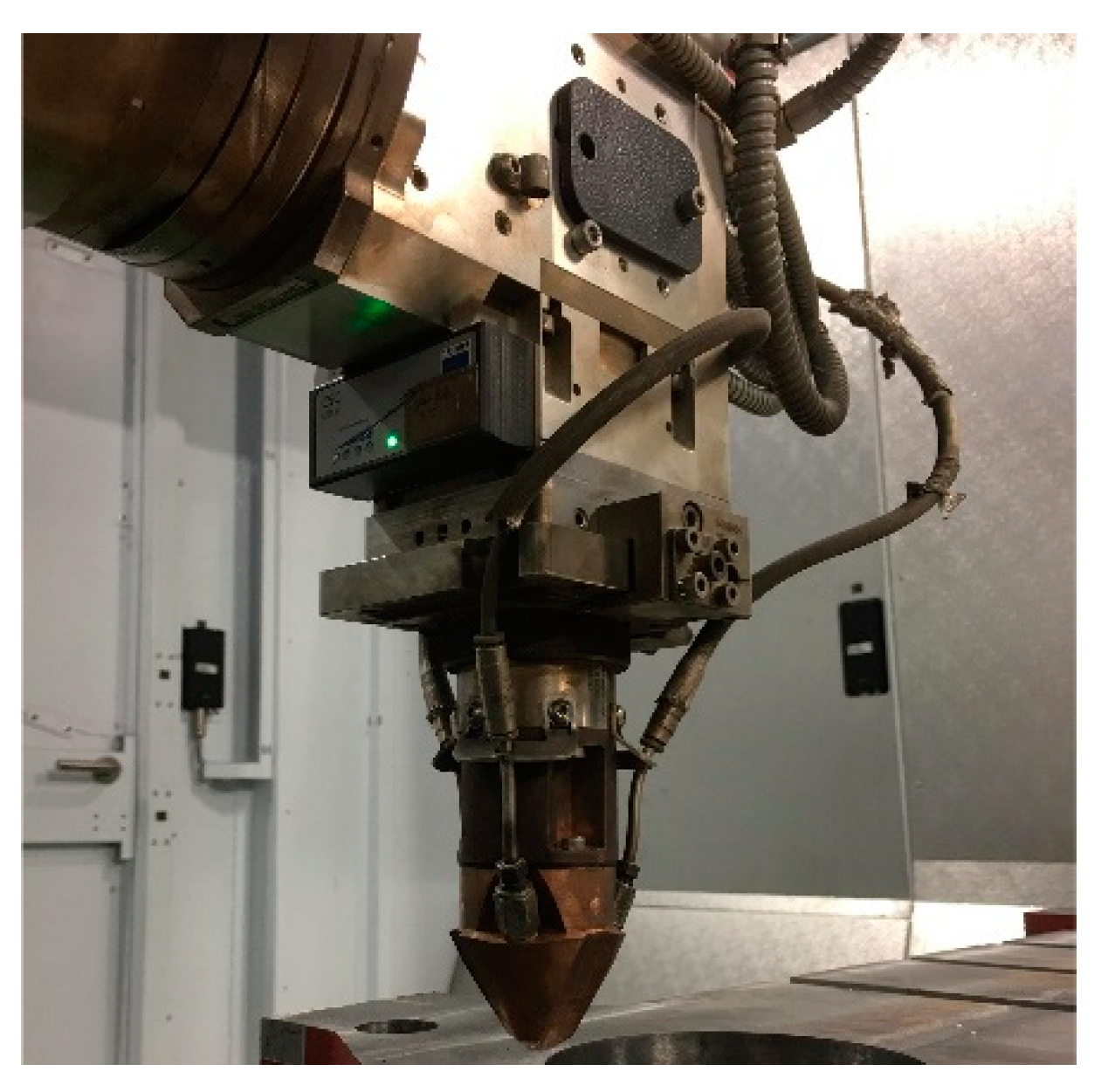

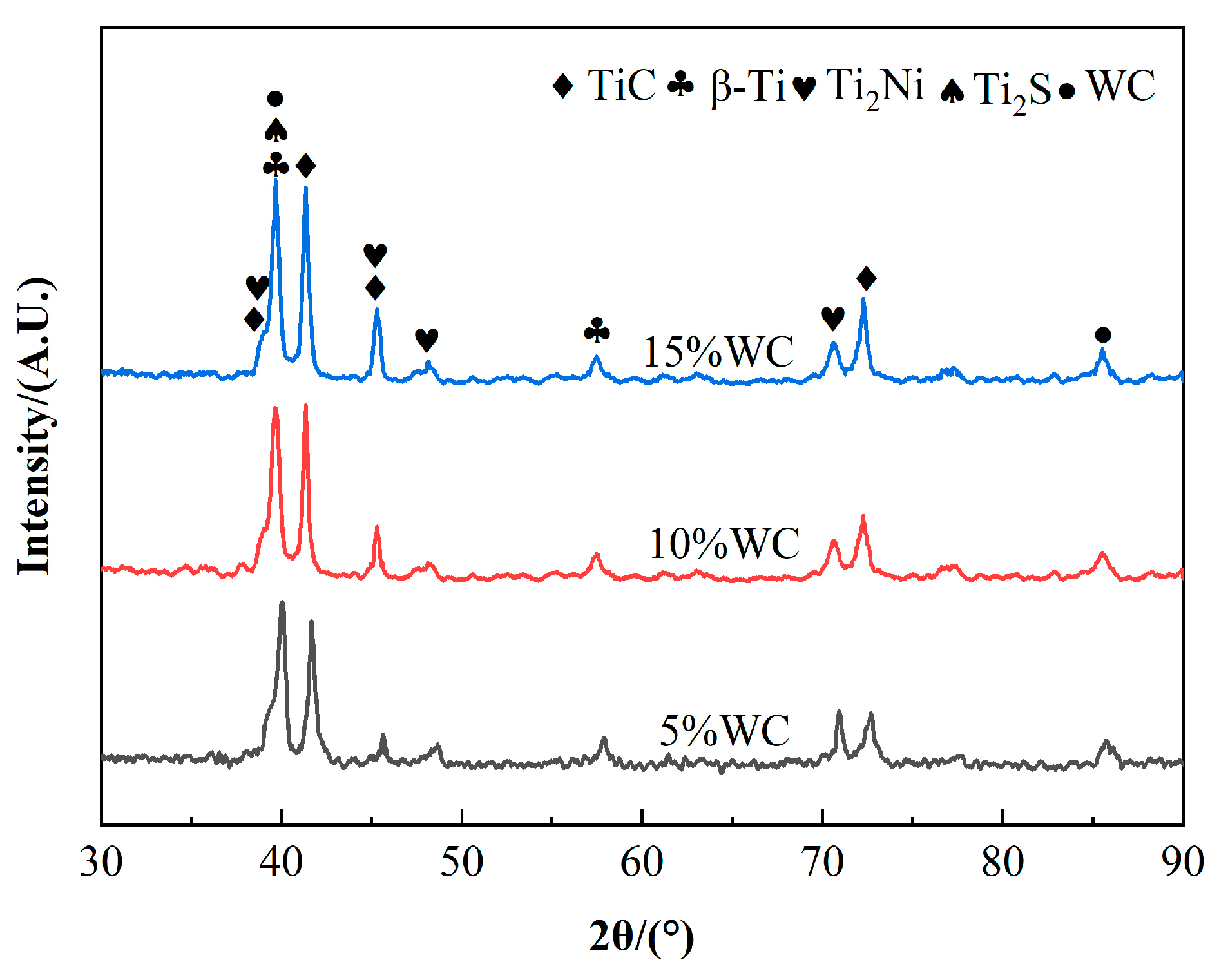
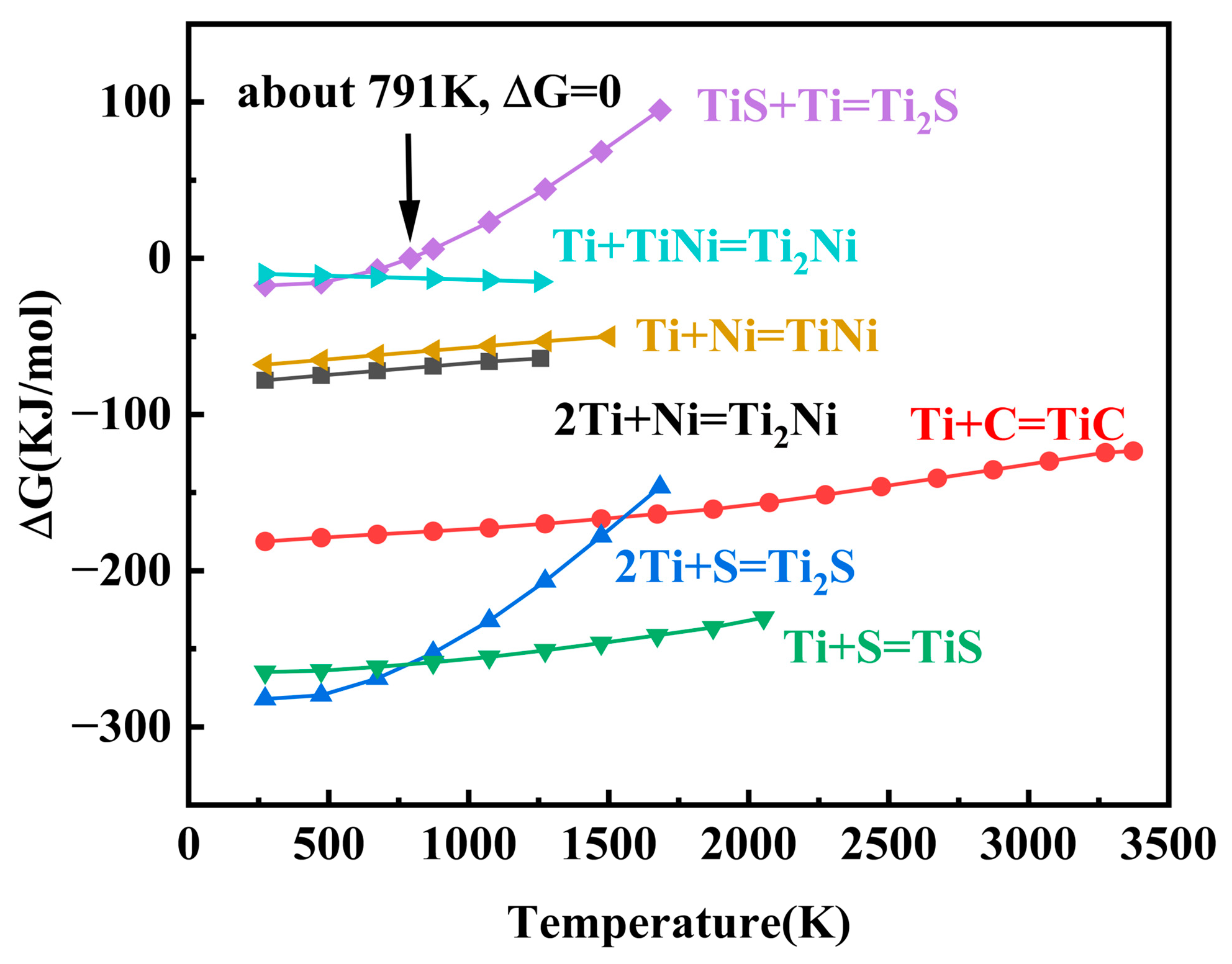

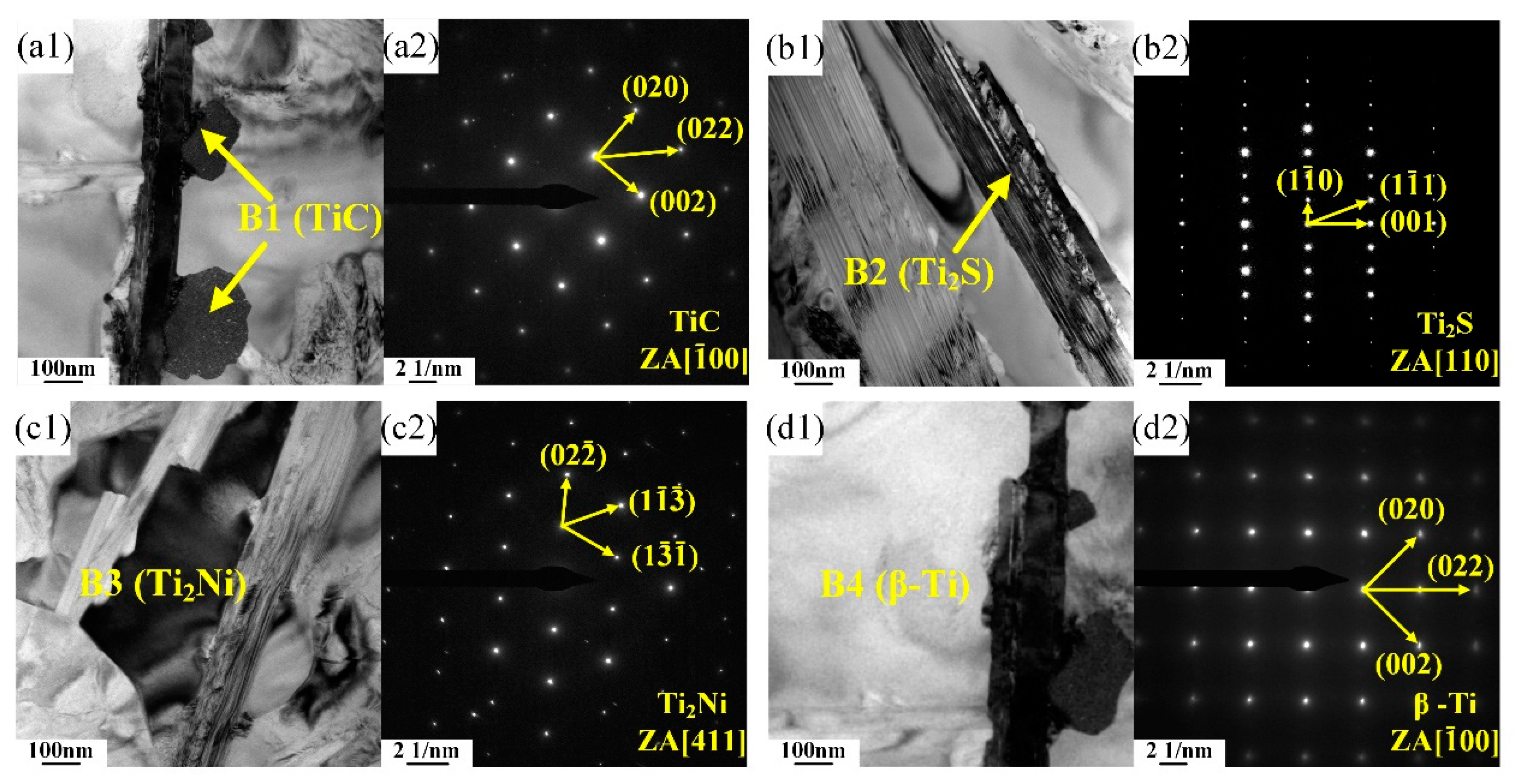
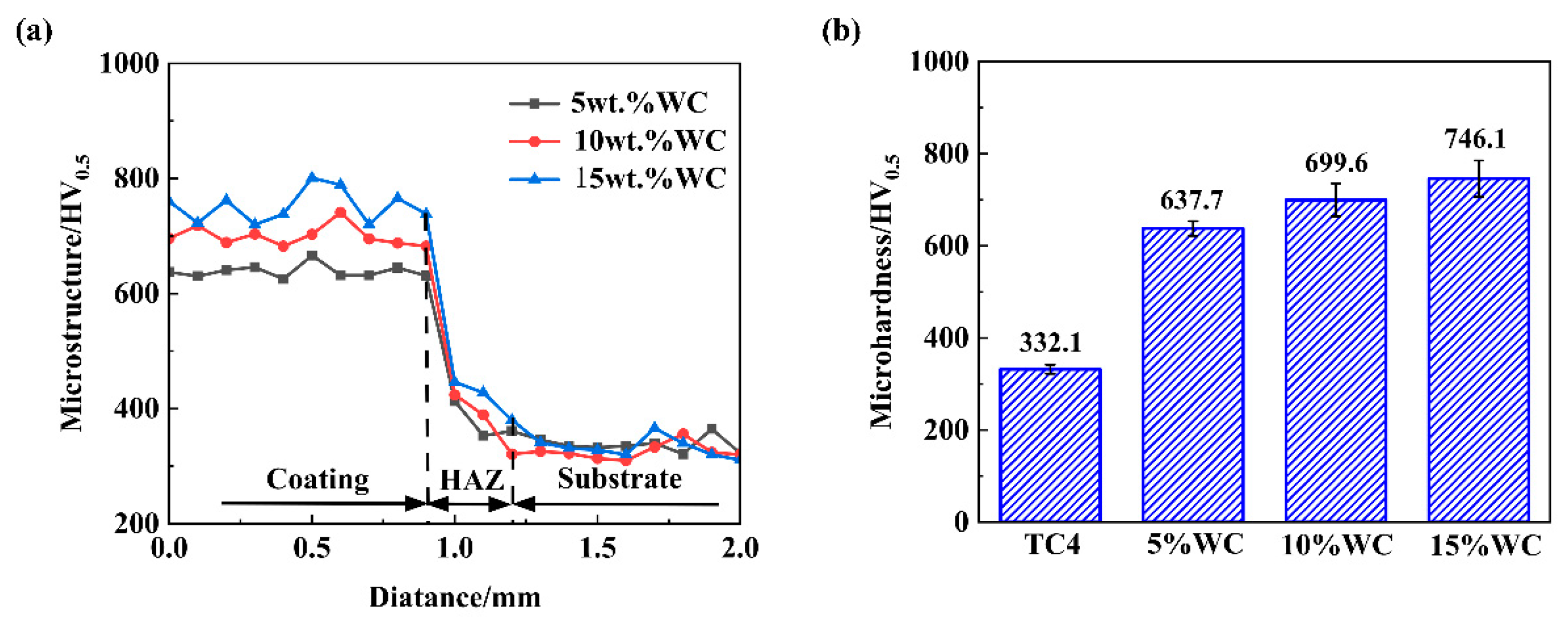

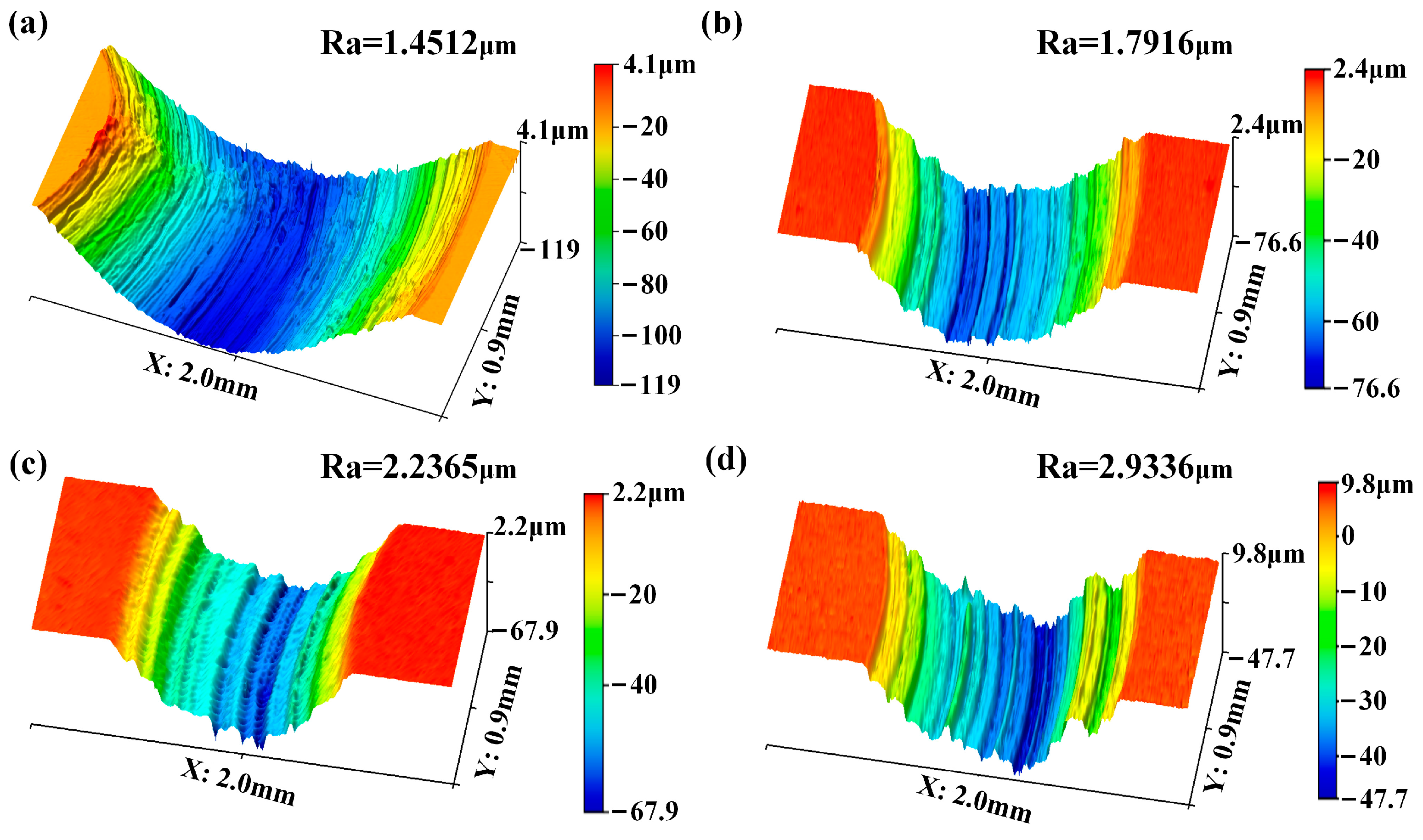
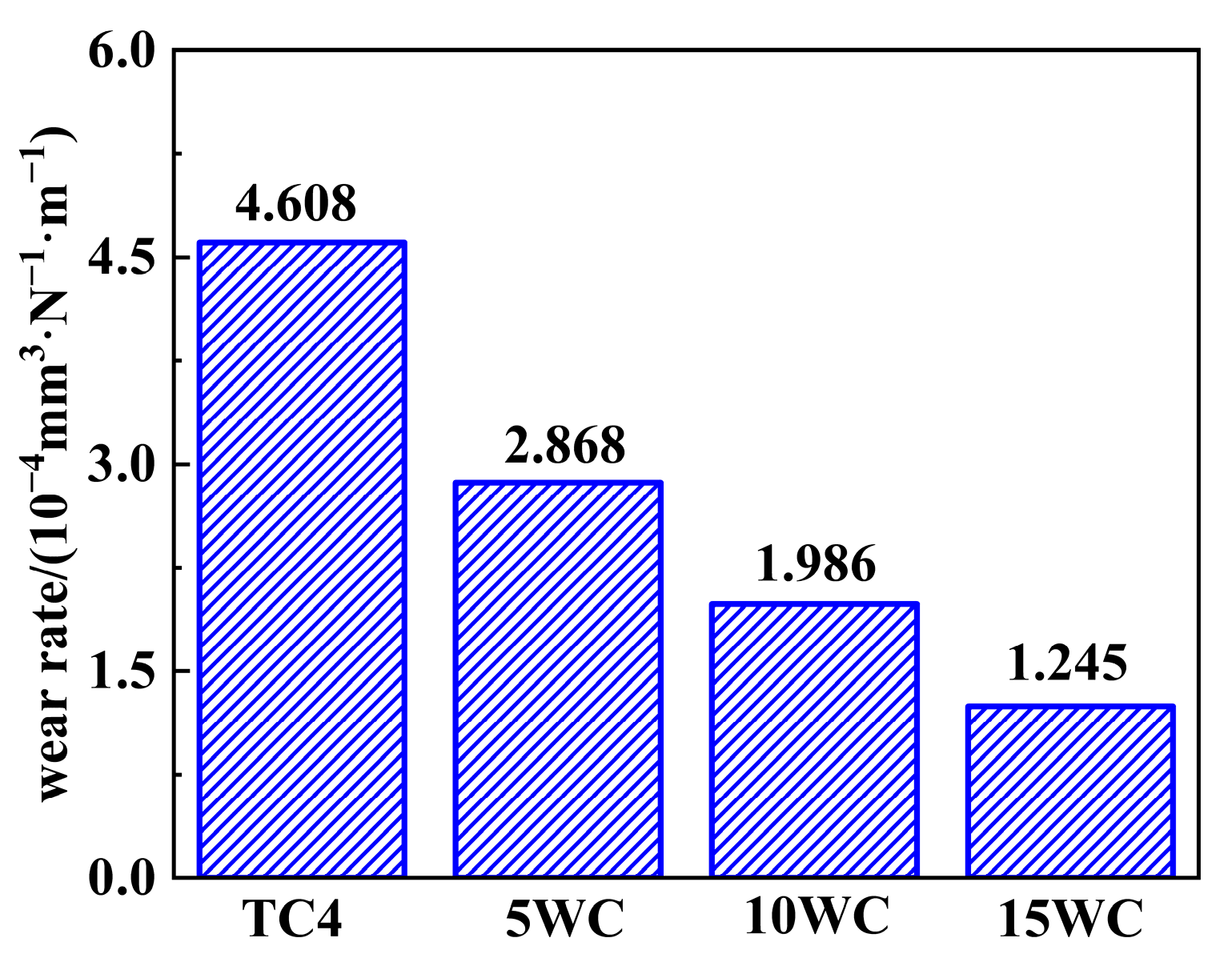
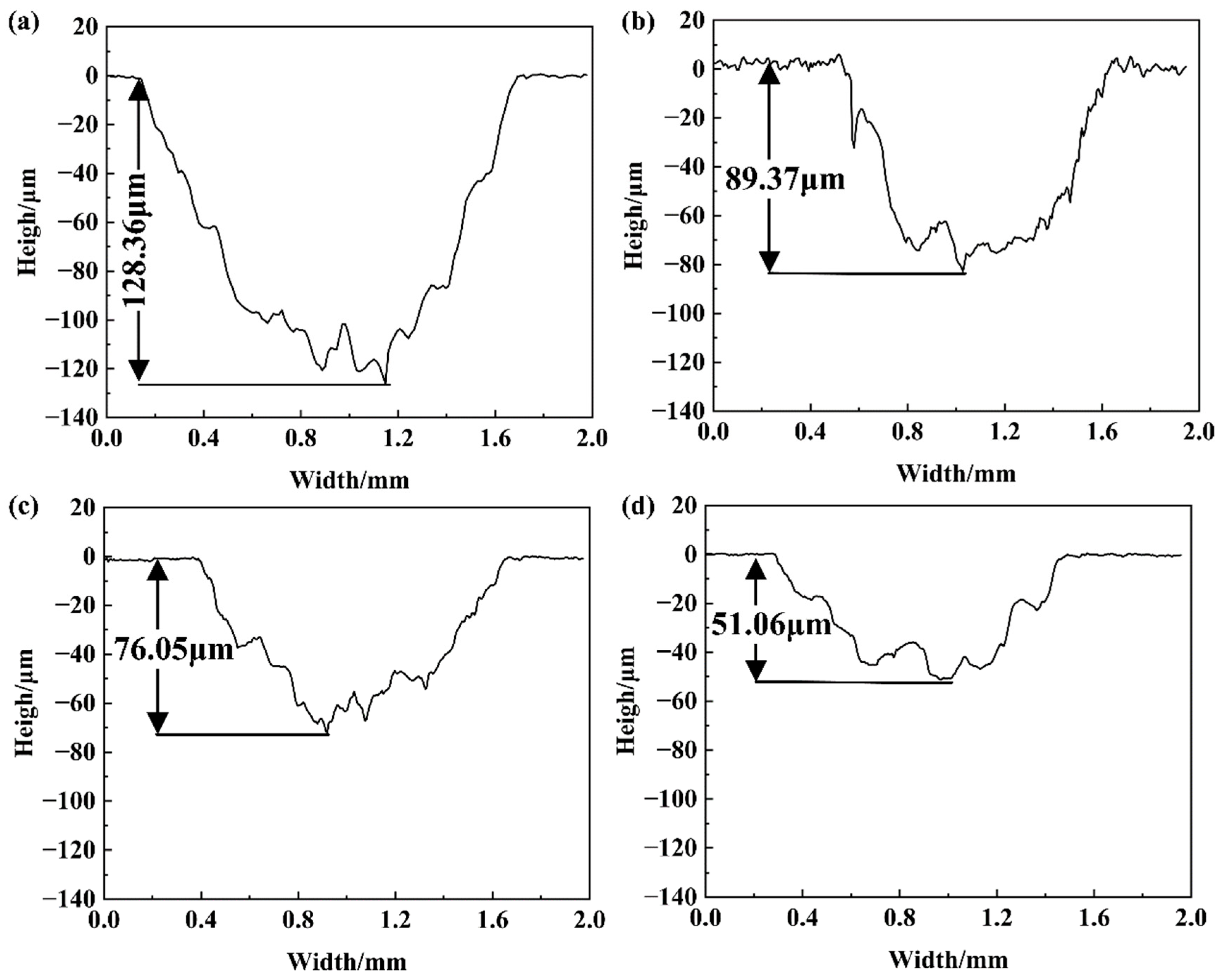
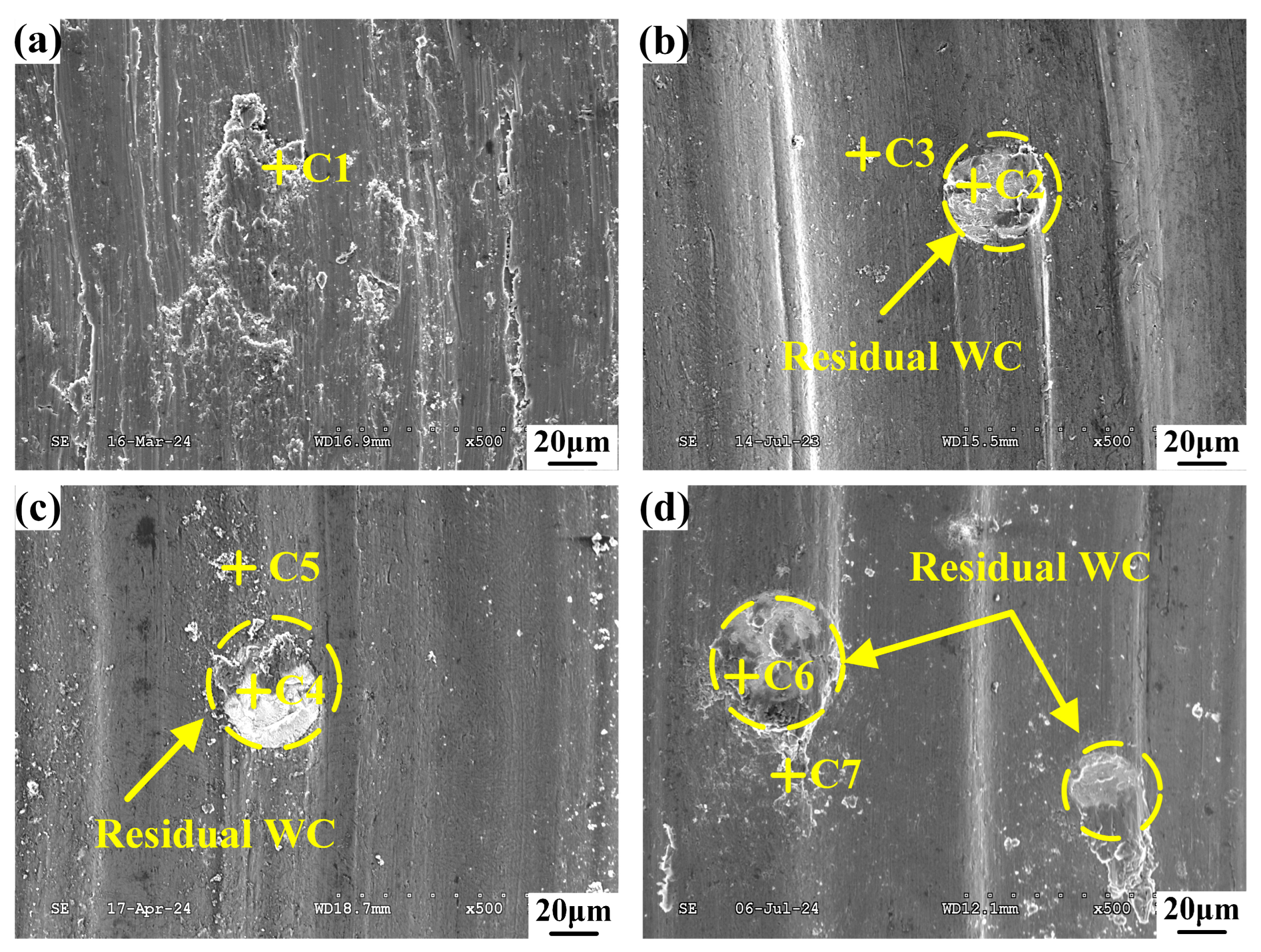
| Elements | Al | V | Fe | C | N | O | Ti |
|---|---|---|---|---|---|---|---|
| Content | 6.04 | 4.01 | 0.15 | 0.014 | 0.009 | 0.165 | Bal |
| No. | Coating | TC4/wt.% | WC/wt.% | Ni-MoS2/wt.% |
|---|---|---|---|---|
| 1 | 5 wt.% WC | 60 | 5 | 35 |
| 2 | 10 wt.% WC | 55 | 10 | 35 |
| 3 | 15 wt.% WC | 50 | 15 | 35 |
| Elements | Al | V | Fe | C | N | O | Ti |
|---|---|---|---|---|---|---|---|
| Content | 6.36 | 4.06 | 0.05 | 0.12 | 0.011 | 0.077 | Bal |
| Elements | WC | Mo | Fe | Ca | K | Mg | Al |
|---|---|---|---|---|---|---|---|
| Content | ≥99.8 | 0.010 | 0.020 | 0.0020 | 0.0015 | 0.0020 | 0.020 |
| Parameters | Value |
|---|---|
| Laser power (W) | 700 |
| Scan speed (mm/min) | 360 |
| Spot diameter (mm) | 3 |
| Overlap ratio (%) | 50 |
| Powder feed rate (g/min) | 3 |
| Powder gas flow rate (He) (L/min) | 5 |
| Shield gas flow rate (Ar) (L/min) | 18 |
| No. | Device (Material) Name | Device Model | Experimental Purpose | Remark |
|---|---|---|---|---|
| 1 | XRD | X’Pert-Pro MPD (Nalytica, Almelo, The Netherlands) | Initial determination of phases | Scanning range: 30~90°, Scanning speed: 6°/min |
| 2 | SEM | Hitachi S-3000N (Hitachi, Tokyo, Japan) | Macro-Microstructure analysis | |
| Wear topography analysis | ||||
| 3 | EDS | Oxford INCAPentaFET-x3 (Oxford Instruments, Oxford, UK) | Element composition of phases | |
| 4 | TEM | FEI-Tecnai G2 F30 (Field Electron and Ion Company, Hillsboro, OR, USA) | Phases confirmation | |
| 5 | Microhardness tester | KB 30SR-FA (KB Pruftechnik, Munich, Germany) | Microhardness analysis | Applied load: 5 N, Test time: 12 s |
| 6 | Tribology Tester (Dry) | RTEC MFT-5000 (RTEC-instruments, San Jose, CA, USA) | Evaluation of tribological properties | Normal load: 5 N, Test time: 60 min Grinding ball: Al2O3 (1.5 mm) |
| 7 | Non-contact white light interferometer profiler | RTEC UP-Lambda (US) | Wear profile analysis |
| Phase | Proportion | Ti | W | C | Al | V | Ni | S | Mo |
|---|---|---|---|---|---|---|---|---|---|
| A1 (TiC) | wt.% | 63.23 | — | 36.77 | — | — | — | — | |
| at.% | 50.36 | — | 49.64 | — | — | — | — | ||
| A2 (TiC) | wt.% | 66.59 | — | 33.41 | — | — | — | — | |
| at.% | 52.66 | — | 47.34 | — | — | — | — | ||
| A3 (Ti2S) | wt.% | 58.66 | 2.50 | 2.42 | 2.68 | 3.29 | 7.90 | 21.63 | 2.18 |
| at.% | 57.35 | 2.52 | 3.18 | 2.45 | 1.43 | 5.25 | 25.69 | 2.03 | |
| A4 (Ti2Ni) | wt.% | 44.66 | 5.89 | 4.37 | 1.99 | 2.65 | 25.94 | 7.96 | 6.54 |
| at.% | 40.36 | 3.35 | 12.65 | 4.21 | 2.03 | 19.35 | 8.59 | 9.46 | |
| A5 (β-Ti) | wt.% | 74.24 | 6.61 | 1.54 | 4.11 | 3.03 | 3.07 | 1.35 | 6.05 |
| at.% | 71.45 | 5.33 | 6.02 | 3.25 | 1.77 | 2.44 | 2.63 | 7.11 |
| Phase | Proportion | Ti | W | C | Al | V | Ni | S | Mo | O |
|---|---|---|---|---|---|---|---|---|---|---|
| C1 | wt.% | 78.69 | — | — | 11.58 | 5.55 | — | — | — | 4.18 |
| at.% | 75.96 | — | — | 12.59 | 8.46 | — | — | — | 12.81 | |
| C2 | wt.% | 5.28 | 75.87 | 8.73 | 0.96 | 1.05 | 2.08 | 1.33 | 0.67 | 4.03 |
| at.% | 7.07 | 37.86 | 40.63 | 1.07 | 1.33 | 2.28 | 0.88 | 0.72 | 8.16 | |
| C3 | wt.% | 15.34 | 46.08 | 4.47 | 1.52 | 1.44 | 14.01 | 8.14 | 2.32 | 6.58 |
| at.% | 18.55 | 20.98 | 21.31 | 2.24 | 13.91 | 13.91 | 6.04 | 3.06 | 12.85 | |
| C4 | wt.% | 7.82 | 72.61 | 7.33 | 1.75 | 1.63 | 3.21 | 0.65 | 1.07 | 3.93 |
| at.% | 10.01 | 35.23 | 37.07 | 2.36 | 2.01 | 4.05 | 0.32 | 1.29 | 7.66 | |
| C5 | wt.% | 18.18 | 42.16 | 5.33 | 0.93 | 0.91 | 15.98 | 9.04 | 3.32 | 4.15 |
| at.% | 23.66 | 22.81 | 20.16 | 1.03 | 0.64 | 12.19 | 8.33 | 4.07 | 7.11 | |
| C6 | wt.% | 8.71 | 68.35 | 9.01 | 2.35 | 0.98 | 3.09 | 1.53 | 0.97 | 5.01 |
| at.% | 9.03 | 33.65 | 39.11 | 2.22 | 1.62 | 3.17 | 1.03 | 0.66 | 9.51 | |
| C7 | wt.% | 14.33 | 45.19 | 5.23 | 3.04 | 0.98 | 18.34 | 7.11 | 1.96 | 3.82 |
| at.% | 18.78 | 22.61 | 20.99 | 4.01 | 0.78 | 15.23 | 6.23 | 2.04 | 9.33 |
Disclaimer/Publisher’s Note: The statements, opinions and data contained in all publications are solely those of the individual author(s) and contributor(s) and not of MDPI and/or the editor(s). MDPI and/or the editor(s) disclaim responsibility for any injury to people or property resulting from any ideas, methods, instructions or products referred to in the content. |
© 2024 by the authors. Licensee MDPI, Basel, Switzerland. This article is an open access article distributed under the terms and conditions of the Creative Commons Attribution (CC BY) license (https://creativecommons.org/licenses/by/4.0/).
Share and Cite
Wang, C.; Yan, X.; Zhang, T.; Zhang, Q.; Zhang, Z. Microstructure and Tribological Properties of WC/Ni-MoS2 Titanium-Based Composite Coating on TC4. Coatings 2024, 14, 1157. https://doi.org/10.3390/coatings14091157
Wang C, Yan X, Zhang T, Zhang Q, Zhang Z. Microstructure and Tribological Properties of WC/Ni-MoS2 Titanium-Based Composite Coating on TC4. Coatings. 2024; 14(9):1157. https://doi.org/10.3390/coatings14091157
Chicago/Turabian StyleWang, Changhao, Xiaohui Yan, Tiangang Zhang, Qiyu Zhang, and Zhiqiang Zhang. 2024. "Microstructure and Tribological Properties of WC/Ni-MoS2 Titanium-Based Composite Coating on TC4" Coatings 14, no. 9: 1157. https://doi.org/10.3390/coatings14091157





